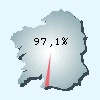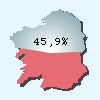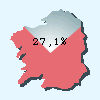| Language proficiency As we can see from this overview of the general levels of language proficiency, the Galician language holds a very priviledged position vis à vis the other lesser used languages of Europe and also enjoys a particularly favourable context in order for the development of language planning geared to securing the completely normal usage of the language to be successful. | |||
Language proficiency | |||
 Can understand Galician |
 Can speak Galician |
 Can read Galician |  Can write Galician |
The figure of 97.1% given refering to the percentage of the population which can understand Galician refers to an 'effective' level of understanding, but when the author of the SLMG talk about 'real' levels of understanding, this figure rises to 99.9%. As far as proficiency in the spoken language in concerned, over 85% of the population claim to be able to speak Galician. And only a fraction of the first-language Spanish-speakers claim to be completely unable to speak Galician. These high levels of proficiency registered for the spoken language hold true regardless of generation differences. As regards proficiency in the written language (reading and writing), the information is rather more variable, and here age and the level of studies are just two of the factors which tend to exert an influence on the levels registered. The percentages are considerably lower than those for either active or passive oral proficiency. These figures should not alarm us, however, when we bear in mind the social situation our language is in. We should not forget that from the very outset, compulsory education was taught exclusively in Spanish, and yet inspite of this fact, further aggravated by other well-known factors, there is still a high percentage of the population which is able to read and write the language it speaks. The SLMG also makes the following remark regarding this particular question ; "owing to the fact that Spanish tends to monopolize the greater part of all written materials, it is possible that the population feels no actual need to learn to read in Galician....". The figures for reading and writing proficiency in Galician rise sharply when we go on to look more closely at the younger generations, and people with secondary or university qualifications, and it is fair to say that these higher percentages are the result of integrating Galician into all levels of education. | |||
Back to Galician today